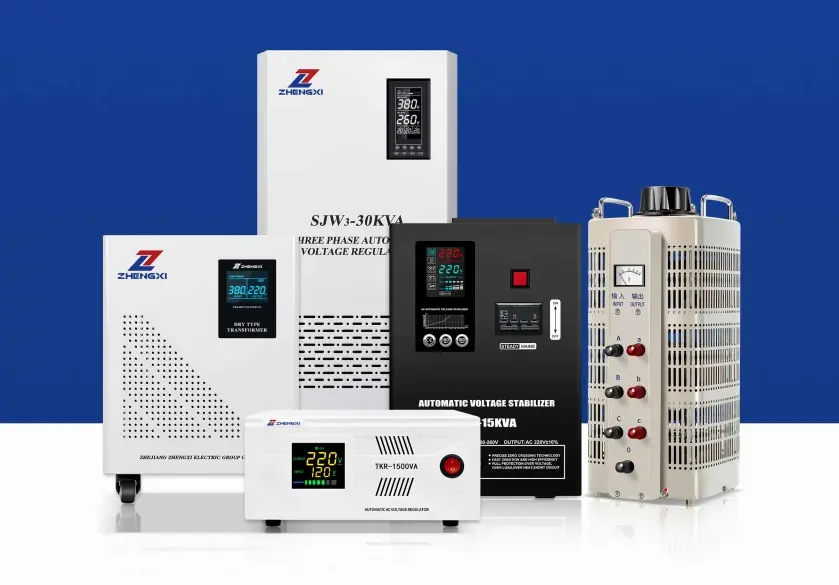Voltage fluctuations can cause significant damage to sensitive electrical equipment, leading to costly repairs and replacements. Whether you’re using household appliances, industrial machinery, or electronics, a voltage stabilizer can help ensure the safety and longevity of your devices. In this guide, we’ll explore everything you need to know about voltage stabilizers, from how they work to how to choose the best one for your equipment.

Key Takeaways
- Voltage stabilizers protect your equipment from voltage fluctuations, extending their lifespan.
- The three main types of stabilizers—relay type, servo controlled, and static—are suited for different needs.
- When choosing a stabilizer, consider the power rating, application, and the type of voltage fluctuation.
Understanding Voltage Stabilizers
A voltage stabilizer is a device designed to maintain a steady voltage level for your electrical equipment, ensuring it receives a consistent and safe power supply despite fluctuations in the input voltage. Voltage variations can damage appliances, especially sensitive electronic devices like televisions, computers, and industrial machinery. A voltage stabilizer actively adjusts the incoming voltage, protecting your equipment from over-voltage, under-voltage, and power surges.
How Voltage Stabilizers Work Voltage stabilizers typically have a transformer, a voltage sensing circuit, and a control mechanism. When the incoming voltage is too high or too low, the stabilizer adjusts it to a safe level, ensuring that your appliances receive a steady power supply.
- Boost: Increases voltage when it’s too low.
- Buck: Decreases voltage when it’s too high.
- Auto-adjusting: Modern stabilizers use automated systems to adjust voltage continuously without manual intervention.
Types of Voltage Stabilizers
Voltage stabilizers come in various types, each with its own mechanism and level of efficiency. The most common types include:
- Relay Type Voltage Stabilizers
These are ideal for home use and handle moderate voltage fluctuations. They work by using relays to switch transformer tappings based on the input voltage.- Advantages: Cost-effective, easy to use.
- Limitations: Slower response time, not ideal for sensitive electronics.
- Servo Controlled Voltage Stabilizers
Servo-controlled stabilizers provide more precise voltage regulation. They use a servo motor to move a tap on the transformer, allowing continuous voltage adjustment.- Advantages: High precision, stable output, suitable for sensitive equipment.
- Limitations: Higher cost and more maintenance due to mechanical parts.
- Static Voltage Stabilizers
These are advanced stabilizers that use solid-state components like Insulated Gate Bipolar Transistors (IGBTs) for rapid and precise voltage regulation without any moving parts.- Advantages: No mechanical parts, high efficiency, minimal maintenance.
- Limitations: Generally more expensive than other types.

Key Factors to Consider When Choosing a Voltage Stabilizer
1. Power Rating The power rating of a voltage stabilizer indicates how much load it can handle. To ensure proper performance, select a stabilizer with a power rating that matches or exceeds the combined wattage of your appliances. You can calculate the total wattage by adding the wattage of each appliance and considering a buffer for startup surges.
2. Application Voltage stabilizers are used across various applications, including:
- Home Appliances: Protecting TVs, refrigerators, and air conditioners.
- Industrial Equipment: Safeguarding motors, machinery, and other sensitive industrial devices.
- Commercial Spaces: Ensuring stable voltage for electronic devices, lighting, and point-of-sale systems.
3. Voltage Fluctuation Frequency If you live in an area with frequent voltage fluctuations, investing in a higher-quality stabilizer, like a servo-controlled or static model, may be more beneficial for your sensitive equipment.
Advantages of Using a Voltage Stabilizer
Using a voltage stabilizer offers several key benefits:
- Protects Your Equipment: Prevents damage from voltage fluctuations, ensuring the longevity of your appliances.
- Improves Performance: Stable voltage enhances the efficiency of your devices.
- Reduces Repair Costs: By preventing damage, stabilizers help minimize the need for costly repairs or replacements.
- Energy Efficiency: Provides consistent power, which can improve the overall performance and energy efficiency of your equipment.
Common Issues with Voltage Stabilizers and Solutions
- Failure to Maintain Stable Voltage: This can occur if the internal components malfunction. Regular maintenance and checking the stabilizer’s internal parts can help.
- Overheating: Overloading the stabilizer or poor ventilation can lead to overheating. Ensure the stabilizer is used within its rated capacity and place it in a well-ventilated area.
- Relay Malfunctions: In relay-type stabilizers, worn-out relays may cause delayed switching. Replacing faulty relays or opting for servo or static stabilizers can resolve this.
How to Choose the Right Voltage Stabilizer for Your Equipment
- Assess Your Power Needs: Start by determining the total wattage of the devices you need to protect. Choose a stabilizer that meets or exceeds your power requirements.
- Consider Your Budget: While relay type stabilizers are affordable, servo and static stabilizers offer better precision and reliability at a higher cost.
- Choose the Right Type: For sensitive electronics, consider servo-controlled or static voltage stabilizers for higher accuracy. For general household use, a relay-type stabilizer should suffice.
- Check Warranty and Support: Ensure the stabilizer comes with a warranty and after-sales support to handle any potential issues.
Conclusion
Investing in a voltage stabilizer is a wise decision to protect your valuable electrical equipment from voltage fluctuations. By carefully evaluating your power needs and understanding the different types of stabilizers, you can ensure your appliances run smoothly and efficiently for years to come. Whether you need a simple relay-type stabilizer for your home or a precise servo-controlled model for industrial machinery, there is a voltage stabilizer suited to your needs.
Frequently Asked Questions
Is a stabilizer the same as a surge protector?
No, a stabilizer regulates and maintains steady voltage, while a surge protector shields devices from sudden voltage spikes.
Do I really need a voltage stabilizer?
If you live in an area with frequent voltage fluctuations or own sensitive equipment, a stabilizer is highly recommended.
How to stabilize fluctuating voltage?
You can use a voltage stabilizer to automatically regulate the voltage. Additionally, consider using a UPS (uninterruptible power supply) to protect your electronics from power surges and interruptions.
By following these guidelines, you can make an informed decision and select the best voltage stabilizer for your needs, ensuring the protection and longevity of your equipment.
Related Blogs
- How Much Load Can a 5kVA Stabilizer Handle? A Complete GuideA 5kVA stabilizer (or 5kVA automatic voltage stabilizer/AVR) is designed to protect appliances from voltage fluctuations. But how much load
- What is the Cost of a 3KVA Voltage Stabilizer?(2024 Price Guide)If you’re looking for a reliable and affordable 3KVA voltage stabilizer, understanding the price range is essential. The cost of
- What Is the Voltage of Industrial 3‑Phase Power?Industrial facilities—from manufacturing plants to data centers—depend on stable, high‑capacity electrical power. A reliable 3‑phase voltage stabilizer (also called a
- What Is the Difference Between Relay, Servo, and Static Voltage Stabilizers?A voltage stabilizer protects electrical equipment from supply voltage fluctuations. Depending on control technology, stabilizers fall into three main categories:
- How to Choose the Right 3-Phase Voltage Stabilizer for Your NeedsA 3-phase voltage stabilizer (also known as a three-phase voltage regulator) is essential for protecting sensitive equipment from power fluctuations.

